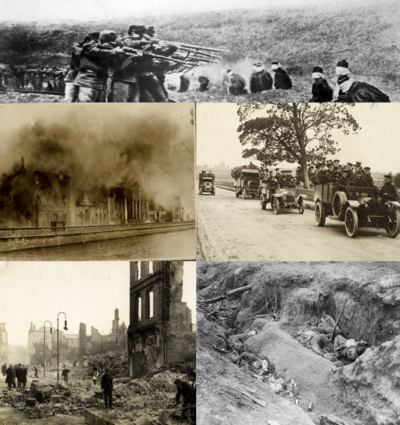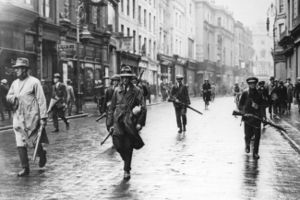Second Gjorkan Civil War
| Second Gjorkan Civil War | ||||||||
|---|---|---|---|---|---|---|---|---|
 (Clockwise from top) Execution of deserters by Loyalist Forces, Volunteers leaving to join the Revolutionary Fight, Captured Trench filled with dead Socialists, Ruins of Nomakoa following the capture of the city by Revolutionary Forces, Burning of the Gjorkan Royal Palace as Revolutionary and Loyalist Forces fight for control of Gjorka City . | ||||||||
| ||||||||
| Belligerents | ||||||||
|
| |||||||
| Commanders and leaders | ||||||||
|
|
|
| ||||||
| Strength | ||||||||
| 3,100,000 Soldiers | 6,000,000 Soldiers | 2,000,000 Soldiers | ||||||
| Casualties and losses | ||||||||
|
1,110,000 Dead 1,550,000 Wounded |
3,000,000 Dead 1,500,000 Wounded |
1,500,000 Dead 300,000 Wounded | ||||||
| Civilians: 3,000,000 Dead, Unknown Wounded | ||||||||
The Second Gjorkan Civil War was an armed conflict in Gjorka fought between Loyal Government Forces, Revolutionaries and Socialists. The war is the bloodiest conflict in Gjorkan history, and saw the deaths of nearly 5.5 million soldiers and over 3 million civilians.
The war started following the First Blue Revolution, and first fought between forces loyal to the Gjorkan Government, and Revolutionary forces seeking to overthrow the government and install democracy. Despite initial back and forth in the war, it eventually stalled into a series of trench warfare. This system along with outdated tactics caused swaths of Gjorkan deaths. In 1917 the revolutionary military overthrew the revolutionary government leading to the split of socialist. leaders, and the entering of socialist forces into the war. By 1919, the Revolutionary forces emerged victorious, however the military government stayed in power after their victory creating the Second Gjorkan Republic.
Contents
Background
First Blue Revolution
Conditions only grew worse following the 1908 Gjorkan Stock Market Crash, and tension throughout the nature grew. Underground groups began forming, the most prominent of these groups was Gjorka United led by Arthur McAllister. In just six months, McAllister organized hundreds of protests throughout Gjorka putting pressure on local government for increased representation, better working conditions, or resignation of corrupt officials. He had evaded Government capture a number of times, but finally on October 30, 1910 he was captured. This sparked a wave of protests across Gjorka beginning the First Blue Revolution. However, by January of 1911 these Protests had begun to die down, until the labour unions of Nomakoa banded together announcing a city wide strike. News of the strike spread, and convinced more unions to also go on strike creating a nationwide strike. The brutal crackdown on these strike re-ignited the flame of protest, and allowed the Socialists Unions and Democratic Protestors to band together. The Government declared martial law throughout Gjorka and the military occupied Nomakoa. In response, the Nomakoa Workers Council declared the government illegitimate and organized militias to fight back against the occupying forces. News of this rebellion in Nomakoa reached revolutionary militias near Gjorka City, causing them to organize a March on Gjorka City led by George Cox. The impending march on Gjorka City and rebellion in Nomakoa caused the High Court to flee to Baltimore. They also mobilized units across the country and withdrew troops from Nomakoa. The Nomakoa Workers Council declared the Gjorkan People's Republic in Nomakoa and following the capture of Gjorka City by George Cox he declared the Gjorkan Revolutionary Government with Joseph Vanderburg as its president beginning the Civil War.
Early War
The 40 Days
After the success of the Blue Revolution and creation of the Gjorkan Revolutionary Government, hundreds of thousands of Gjorkans left to join in the revolutionary cause. The Loyalist Military was in chaos as units were facing mass desertions, and harassment from locals as they marched to Baltimore to join the High Court's flight. Similar problems were faced by the revolutionaries as they attempted to set up a government. Volunteers and Recruits flooding in from across the country were breaking into fights as they waited to join the revolution. The socialist government in Nomakoa was also facing problems establishing control over their territory. Their similar goals, and shared problems caused the Revolutionary Government in Gjorka City to negotiate a Government of Unity with the Socialist Government that had taken power in Nomakoa. Most early battles in the war were no more than skirmishes as both sides faced trouble with organization. This period of disorganization and chaos became known as the 40 days.
First Year
Once both sides began forming into cohesive armies the bloodshed began. The revolutionaries dwarfed their loyalist enemies in terms of manpower, but had almost no effective military commanders. The loyalists massacred hundreds of thousands of revolutionaries in the first year of the war, handing them devastating losses. Even managing to capture Gjorka City, and arrive at the outskirts of Nomakoa. However, a young military officer named Éamon de Valera took charge of the defense of Nomakoa after the death of his general. He won several battles against the loyalists and pushed them back from Nomakoa, and began marching on Gjorka City. His successes revitalized the revolutionary cause, and his rapid advances were threatening the Loyalist cause. In response the Loyalists began building a system of trenches to halt the Revolutionary assault. This tactic was extremely successful, and the Revolutionary advance completely stalled. This system of trench warfare lasted for the remainder of the war.
The Long Death
Late War
Socialist Split
As the war dragged on, and casualties were piling up, dissent began to grow in cities under revolutionary control. In response to this Éamon de Valera, now Commander of the entire Revolutionary Forces, began to brutally crack down on these protests. Many of the protesters were pacifist socialist were decided to work in the factories rather than fight on the front. This suppression of their members, greatly angered the socialist bloc of the Unity Government. Valera was forced to withdraw from command of frontline forces to handle the growing situation. Frustrated with the socialists, and their consistent demands for democratic process, Valera took control of the Assembly building and kicked the socialists from the Unity government. He officially suspended the Revolutionary Assembly, and took direct military control over the government. These actions caused a complete split within the revolutionary forces, and remaining socialist leaders fled to Nomakoa to form the People's Republic of Gjorka. From 1917 onward, the civil war was fought between three sides: the Socialists, Revolutionaries and Loyalists.
Surrender of the Loyalists
With the enter of the Socialist Forces into the war came problems for the loyalist forces. Socialist Commanders were incredibly aggressive and pushed hard against the Loyalists. Attacks against Revolutionary forces were significantly less fierce due to their former alliance and shared cause. The Loyalists were forced to devote more soldiers to the socialist front, weakening their defensive lines against the Revolutionaries. Valera seized the opportunity and ordered a massive offensive. After initial failures, the offensive began to break through loyalist lines. The offensive achieved a number of success including the total capture of Gjorka city, the capture of Éire, and finally revolutionary forces began pushing into the great valley. Following the series of massive defeats, Loyalist forces began collapsing, and by January a surrender was negotiated between the revolutionaries and the loyalists following the capture of Rusynia.
The Final Offensive
Following the surrender of the remaining loyalist forces, socialist leaders began attempting to negotiate a ceasefire with revolutionary forces and recreate the Unity Government. However, by this time Valera had grown furious with the socialists, and committed to end them once and for all. In February of 1919 Valera ordered the Final Offensive. Despite their inexperience, and numerical disadvantage, the remaining socialist forces fought extremely hard. The Final Offensive was the bloodiest of the entire civil war, nearly 1/3rd of all revolutionary casualties and 80% of socialist casualties in the civil war occurred during the offensive. These immense casualties caused by the socialist only further Valera's rage leading him to conduct a purge of all suspected socialists in the revolutionary Forces leading to the death of many democratic leaders. As revolutionary Forces pushed into socialist territory, the socialists operated under a system of scorched earth destroying much of the countryside. By the end of the Second Battle of Nomakoa the city had been completely destroyed with only 5% of all structures in the city left standing. On November 11, 1919 the remaining socialist forces surrendered officially ending the Second Gjorkan Civil War.
Atrocities
Loyalist
Revolutionary
Socialist
Foreign Support
Aftermath
Legacy
Film
The War was depicted a number of times during the military government in use as propaganda films. Following the Second Blue Revolution, and the re-establishment of democracy the war became a taboo subject in film making. A big budget film about the war wasn't produced until 2019 when 1917 was released which grossed over a billion pón making it the highest grossing film that year.


